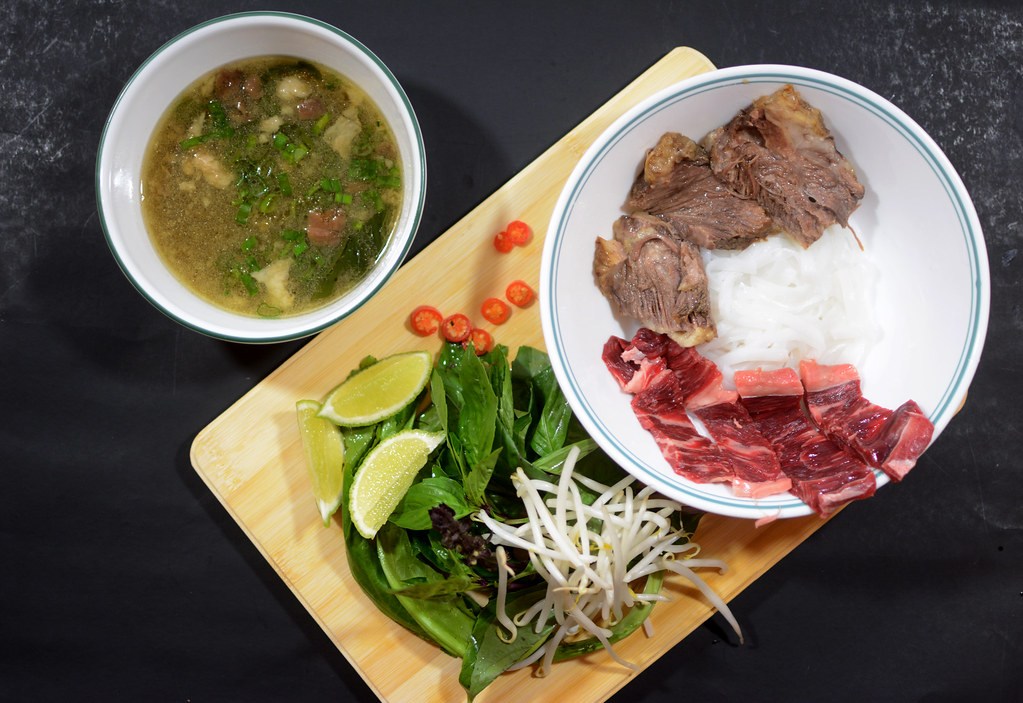It's the most wonderful time of the year, when the office is closed and you're working from home. What better way to spend the time in between emails than to make a big pot of pho?
Lately I've been really into tsukemen, or dipping ramen, ordering it every time Amy and I go out for ramen. It's a relatively new style of ramen, created by Taishoken in 1954. I first learned of this dish when I saw it on the first episode of Mind of a Chef. In the episode, Chef David Chang (of Momofuku fame) travels to Japan to eat ramen, specifically tsukemen. Tsukemen is different from regular ramen in that instead of the noodles sitting in the broth, you actually have the broth on the side and you dip the ramen noodles into the broth. The broth is intensified and has a much stronger flavor, almost sauce like, in comparison to the lighter ramen broths of normal bowls, and the noodles are usually thicker than normal. It's a really fun and delicious way to eat ramen, and for those that aren't super into drinking down the broth, preferring the toppings or the noodles to shine, this is perfect.
I figured that pho is to Vietnam what ramen is to Japan, so this style should translate well. The majority of the steps are exactly the same as making pho (and you can find that recipe here), but there are a few key differences.
So here it is, my Tsuke-pho, I really hope you try it out!
Tsukepho - makes 6-8 servings
For the Broth:
6lbs of beef shin bones
2 lbs of short ribs
2 medium sized yellow onions
1 4 inch piece of ginger
5 star anise
6 cloves
3 inch piece of cinnamon
1 oz chunk of rock sugar (about 1 square inch)
4 tbsp fish sauce
1.5 tbsp salt
For the Bowls:
2 one pound packages of pho noodles, dry or fresh (enough for 6-8 bowls)
1 lb of thinly sliced rib-eye
Limes
Bean Sprouts (can be served slightly steamed or raw)
Thai Basil
Saw tooth herb
Cilantro - diced
Green onion - diced
Sriracha
Hoisin Sauce
2. While the water is coming to a boil, char the onions and ginger over an open flame. If you're in an apartment with electric stoves, use a portable camping stove. For maximum smokey-ness, try charring the onions and ginger over a charcoal fire. Once you get a nice char, rinse off any flakey or black bits from the onions and ginger. Charring the onion and ginger adds a subtle sweetness and smokey note to the broth, and definitely should not be skipped.
3.In a dry pan, toast the star anise, cinnamon and cloves to release the flavorful oils trapped within.
4. Add 6 quarts of cold clean water to the pot, along with the onions, ginger, spices. You would normally also add salt, rock sugar and fish sauce at this step, but because we'll be reducing the broth much further than we would with normal pho, save the seasoning until the end, otherwise it'll be too hard to predict the end flavor.
5. Sear your short ribs to develop a nice crust, add this to the pot.
6. Bring the whole thing to a boil over high heat, then reduce to low and simmer for 5 hours. Skim off any gunk that floats to the top, and any of the fat if you'd like.
7. Now comes the fun part, remove all the bones and meat from the broth and strain. You should be left with a clear pho broth. At this point, you can choose to just season it and eat it as normal pho, but normal is boring. Take your beef bones, and carefully remove the marrow from the bones (these should be super tender and almost falling apart.) Add this marrow and both of the now mushy onions back to the broth. Using a stick blender, blitz the onions and marrow until no more large chunks are visible, this will help make the broth super rich and thick. Turn the heat up to high and reduce the broth down by 1/2. You should be left with about 2 quarts at the end.
8. Add the rock sugar, salt and fish sauce, and adjust to taste. It should taste extremely strong. Since the noodles are unseasoned, we need the broth to bring all the flavor here.
9. Cook your noodles al dente, slice up the meat and serve! To eat, dip your noodles into the broth and slurp it up.



No comments:
Post a Comment